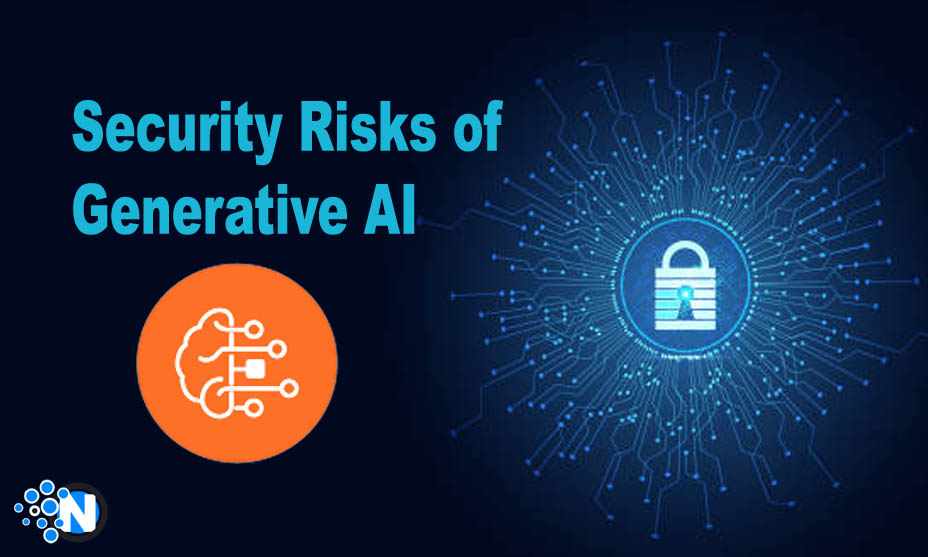
The world is growing rapidly, and it is not easy for any business to compete and sustain its position in the market. Therefore, they need to change their approach and traditional gadget to explore the new world of discoveries and leverage the tool of their benefits. One of them is Artificial Intelligence, Generative AI has taken the world by storm since its launch. Further, the continuous development has made it a tremendous tool for every industry to simplify their complex procedures. However, certain security risks are also associated with its usage. We have listed the details in the under-section.
What is Generative AI?
Generative AI refers to producing texts, videos, images, and other content with the help of machine-learning models and algorithms. Unlike traditional AI, it does not rely on pre-defined or incorporated data structure. As a result, you can receive better results. Furthermore, certain toos integrating generative artificial intelligence let you input customized information and commands to make it work your desired way and deliver the results.
Based on its wide range of functional abilities, it can be used in several fields, including text generation, art creation, and multimedia files. Thus, these diverse outputs make it a powerful innovatory technology to generate tremendous results. You only have to deal with the risk factors associated with this masterpiece to ensure pocketing maximum perks.
Security Risks of Generative AI
After analyzing the benefits of Generative AI, we have processed all the details quite comprehensively to evaluate the major security risks. Some of the top ones are listed below to provide you with enhanced knowledge.
1 – Malicious Content Generation
Content generation is the top benefit of this high-quality AI model. As a result, content writers and blog owners can readily get the necessary data to add to their articles and publish them consistently for better outcomes. Although it brings several unimaginable perks, you must be careful with how your tool works. Sometimes, a slight glitch in the database can cause the generation of false information with poor figures and stats. Similarly, it can lead to the production of misleading images or documents, causing the individuals to work in the wrong direction.
How To Avoid?
- Adopt regular measures to keep the database safe and sound.
- Hire human reviewers to evaluate the content after generation.
- Implement algorithms to find anomalies in the produced data.
- Compare the information with authentic sources to evaluate the range of risk.
2 – Forgery and Fraud
Next, we have listed forgery and fraud among the top security risks. Artificial Intelligence is highly vulnerable and can be manipulated if any down point can be approached. Consequently, it can be used to create fake images, voice recordings, signatures, and biometric data, like fingerprints. Further, these forgeries can be implemented to carry out fraudulent activities. For example, people can perform theft and online stealing by accessing different industries in unauthorized manners, creating a lot of havoc.
How To Avoid?
- Implement robust security methods, like multi-factor authentication and biometric verification.
- Utilize watermarking techniques to enhance the trustworthiness of media.
- Furthermore, limit the access of your employees to your tools.
- Leverage high-end data storage platforms for enhanced security.
3 – Privacy Violations

Privacy violation is another significant risk associated with Generative AI. As mentioned previously, these models feature larger datasets to produce the desired information. However, numerous chances are present that these tools can bring sensitive information in the results, posing a serious threat to the security and privacy of the person. Consequently, if you own a company, you have to face serious negative impacts on your credibility and authenticity, affecting your customer base. Furthermore, you will surely get out of the competition through these violations.
How To Avoid?
- Employ differential privacy techniques for your data.
- Add noise to the database so the models won’t learn the sensitive information easily.
- Utilize highly trained models because they promise the best outcomes.
- Regularly evaluate the generated results to remove privacy violations.
4 – Deepfakes and Manipulated Media
Deepfakes have gained importance in the market for their power to deceive and mislead individuals with different media files. This strategy includes manipulating videos and images with the help of generative AI. Furthermore, they can be used to create realistic-looking videos that can easily misguide any individual or provoke negative thoughts among the young generation, like suicide, rape, and others. Hence, it is crucial to have a strong check on such manipulated media files.
How To Avoid?
- Incorporate advanced AI tools to identify genuine and manipulated content.
- In addition, train your employees to implement deepfake detection algorithms.
- Read the commands before putting them into the work.
- Above all, follow the necessary strategies to limit the generation of such manipulated media.
5 – Bias and Discrimination Amplification
Biasing in the dataset can create a lot of trouble by giving rise to illogical and unnecessary discrimination. Furthermore, it amplifies the results in such a negative direction to create social implications. Besides excluding marginalized groups and reinforcing stereotypes, you can carefully build the dataset curation. Such biasing in the results is always non-productive when using generative AI to make legal decisions. While a slight biasness could be effective and compulsory, you must be very calculative to remove additional amplification.
How To Avoid?
- Curate the dataset carefully and monitor the ongoing processes precisely.
- Fairness-aware training techniques are mighty effective in reducing biasness.
- Lastly, follow inclusive AI-generated content to contribute to more equity.
Final Verdicts
Generative AI possesses the immense potential to streamline your business operations. However, it is crucial to understand the security risks associated with it. Malicious content generation, privacy violations, forgery, deepfakes, and bias amplification are major considerations. You must avoid them to ensure maximum perks from this high-end technology. To avoid such risks, you need a combination of different strategies and regulatory measures to mitigate them. Leverage technical solutions and run user awareness campaigns to ensure this technology’s healthy use and balance innovation and security. As a result, you will move ahead of the market.




